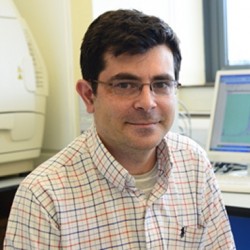By Helen Figueira
October 2, 2012
Time to read: 3 minutes
 New expertise in proteomics and phosphoproteomics comes to the CSC
New expertise in proteomics and phosphoproteomics comes to the CSC
Pedro Cutillas has spent the last five years trying to decipher theintricacies of the signalling pathways involved in cancer. Working as asenior lecturer at the Barts Cancer Institute at Queen Mary University,he developed new techniques to analyse the cascades of signals thatcancer cells rely on to proliferate. He now brings his research andexpertise to the CSC, taking charge of the Biological Mass Spectrometryand Proteomics Laboratory.
Cutillas has long been interested in cancer cell signalling, havingworked and studied at The Ludwig Institute (UCL branch) under MikeWaterfield and Bart Vanhaesebroeck. He previously did a PhD supervisedby Al Burlingame (an expert and pioneer in Biological Mass Spectrometryat UCSF) and Robert Unwin. “There is a theory called oncogeneaddiction,” he reveals, “based on the fact that cancer cells aredependent on the activity of a specific protein or pathway to survive.So if you can identify the pathway that the cancer is addicted to, youcan target it with a drug.” It sounds easy, “you block the pathway, youcure the cancer.” Cutillas pauses, “Though it’s not that simple.” Inpractice, this kind of therapy doesn’t work for all patients. To findout why not, Pedro set about profiling the signalling pathways involved.
“Focussing on new methods for phosphoproteomics,” says Cutillas, “wecan profile signalling in cancer cells.” These pathways are driven bythe activity of protein kinases. The conventional approach assessestheir activity by measuring phosphorylation levels. But the constraintof this approach, Cutillas explains, is that it typically focuses onone kinase at a time or compares two individual samples, each labelledand analysed with mass spectrometry. “Leaving out the labels,” he says,“means you can process each sample individually”. As a result, anynumber of samples can be compared, rather than being restricted topairwise comparisons. “If you want to compare 20, 30 or 50 patients,”he clarifies, “label-based approaches are not ideal.” So he created acomputer program to extract quantitative data from the massspectrometry files without the need for labelling. “It took severalyears to overcome the challenges,” remembers Pedro, but “this has givenus a new way to profile signalling in cancer cells.”
Cutillas brings this expertise in phosphoproteomics to the CSC: “Thisinstitute is very strong in molecular biology, and I hope that myexperience in proteomics can be applied to some of the researchprojects here. I think it will be a powerful combination ofapproaches.” In addition to collaborating with and supporting thegroups of the CSC, Pedro hopes to work on further technologicaldevelopments relevant to the research themes of the CSC, and willmaintain independent research with the supervision of a PhD student whois using phosphoproteomics to investigate how some cancer cells acquireresistance to certain treatments over time. Coming to the CSC presentsan opportunity to expand his work: “I am interested in allpost-translational modifications of proteins. Although my experiencewith phosphoproteomics is particularly useful, I would now like toextend that expertise to make our work relevant to those performed byexisting biology groups at the CSC. Looking at things likeubiquitination, methylation, and factors involved in epigeneticregulation, I will be able to apply similar methods to a much broaderrange of protein modifications.”
-AL